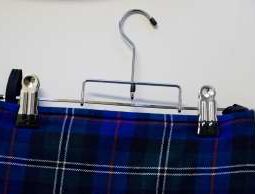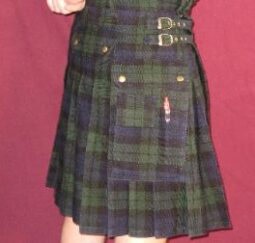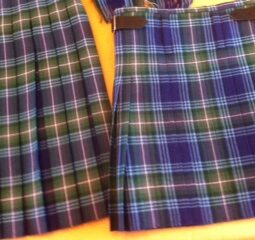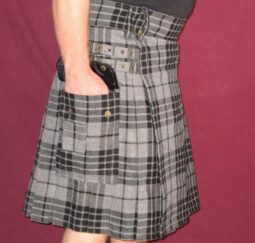$0.00
Out of stock
The kilts I make are all tailor made to your measurements. I believe in communication with my customers resulting in the best kilt possible, so I like to work together on your kilt. I am open to all requests and suggestions. Please feel free to ask. It is generally believed that a “traditional kilt”is the 16oz, knife pleated kilt that is by far the most common kilt today. Actually,the oldest surviving tailored kilt is a regimental kilt for the Gordon Highlanders, c. 1796. It is made from exactly three yards and two inches of cloth, and is box pleated to the stripe. Other kilts surviving from the late eighteenth and early nineteenth century are similar in style; four yards more or less, and box pleated. Military kilts were pleated to the stripe from the beginning. Civilian kilts were at first pleated to no pattern at all, but soon adopted the military fashion of pleating to the stripe. My kilts are hand-pleated and hand-sewn. This method renders the stitching almost invisible and is an integral part of what makes a traditional kilt. No machine stitching is done on any portion. Regardless of style, each kilt features the following: -Made-to-Measure with a 2″ Rise The kilt will be made to your measurements: length, waist, and hips. Rise is the portion that extends above your natural waist and allows the kilt to remain secure. -Pleated to the Sett or to the stripe. To the sett preserves the tartan pattern in the pleats. To the stripe (or regimental) selects one stripe and centres it on each pleat. -Two 1 1/4” cast Metal Buckles with celtic design leather straps and tartan casing The casing will match exactly when pleated to the sett, but not when pleated to the stripe. (In any case, the straps cover the casing.) -Canvas stabilizer. The stabilizer prevents streching when the straps are tightened.The canvas also stabilizes the pleats and relieves the stress pn the pleat stiches.
I make matching flashings for no extra charge, and a heavy duty kilt hanger is included. I will also move the buckles if the need arises at no additional cost.
Types of Tartan • Tartan fabric is available in different weights, which is part of the decision when contemplating a kilt. I recommend not using light weight tartans because they don’t hang or swing properly, and really don’t stay sharp, crisp, and straight. We’ve heard it said that after a relatively short time being seated, the lightweight kilts look like they’ve been slept in…!!! Perhaps not the look you’re hoping for. Most kilt wearers can tell right away who is wearing a lightweight kilt. Lightweight fabrics of all kinds are used mostly in non-traditional kilts or fashion kilts. I do not make fashion kilts since most, if not all, are made with machines and as the man who taught me kilt making says, “a good kilt maker has no use for a sewing machine”. I reccommend tartans that are woven in a range of weights from Medium Weight (13-14 oz) to Heavy Weight (15-16 ounce). For a kilt, most people choose Heavy weight, which gives the ideal balance of warmth, pleat crease-retention, durability, swing, and ease of wear. The mills I deal with, all produce excellent kilt quality tartans. Hundreds of Clan names are available as well as Irish County Tartans. If you are interested , email me the name/district you are interested in and I will research the options and send you images and prices of the tartan. If you supply the Tartan,
Manufactured by: The Kilt Lady
Additional information
| Weight | 0.00 kg |
|---|---|
| Dimensions | 0.00 × 0.00 × 0.00 cm |




